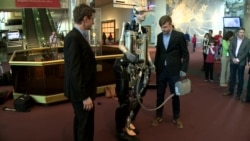WASHINGTON —
A new state-of-the-art robot that walks, talks, grasps, sees and hears was recently the star attraction at an event at the Smithsonian’s National Air and Space Museum, in Washington.
The robot doesn’t walk very well and doesn’t dance, but the two-meter-tall bot holds great promise for the future.
The Incredible Bionic Man, as he is called, is built entirely from artificial body parts and synthetic organs. He is the subject of a new documentary that chronicles the behind-the-scenes aspects of his story.
Host Bertolt Meyer says it explores the question, "how far has medical technology come?"
“What parts of the human body can we already replace today? If we get all of the spare parts that exist and put them together in one piece, what will it look like? And the result is, it looks like this,” explained Meyer.
Like the Bionic Man, Meyer, a psychologist at the University of Zurich, has a bionic hand. The robot also has 27 other artificial body parts.
“He has a great set of artificial organs already; he has an artificial heart, which is already used in patients; the artificial heart pumps artificial blood,” said Meyer.
“He has the same bionic hand as I have, as I was born without my lower left arm, and he sits in a robotic exoskeleton. Think of this as the wheelchair of the future; a device that will restore the ability to walk to people who are paralyzed.”
The bionic man's components were borrowed from some of the world’s leading researchers, including Joan Taylor, professor of pharmaceutics at De Montfort University in Leicester, England. She is the inventor of its pancreas.
“These are important not so much from the robotic point of view but from the contribution to future medicine,” said Taylor.
According to Meyer, those implications are huge.
“This project shows that we can already replace a lot of broken parts and in the near future, technology might do away with many disabilities and with many diseases and illnesses, and society at large will benefit from them,” said Meyer, although he also stressed that the Bionic Man project is not about robots replacing human beings.
“There is no way to replace the human. There is no artificial brain and all of these devices that you see here are designed to interface with the human body.”
As efforts to improve the Bionic Man and his components continue, engineers and doctors work hand in hand to advance the frontiers of human potential.
The robot doesn’t walk very well and doesn’t dance, but the two-meter-tall bot holds great promise for the future.
The Incredible Bionic Man, as he is called, is built entirely from artificial body parts and synthetic organs. He is the subject of a new documentary that chronicles the behind-the-scenes aspects of his story.
Host Bertolt Meyer says it explores the question, "how far has medical technology come?"
“What parts of the human body can we already replace today? If we get all of the spare parts that exist and put them together in one piece, what will it look like? And the result is, it looks like this,” explained Meyer.
Like the Bionic Man, Meyer, a psychologist at the University of Zurich, has a bionic hand. The robot also has 27 other artificial body parts.
“He has a great set of artificial organs already; he has an artificial heart, which is already used in patients; the artificial heart pumps artificial blood,” said Meyer.
“He has the same bionic hand as I have, as I was born without my lower left arm, and he sits in a robotic exoskeleton. Think of this as the wheelchair of the future; a device that will restore the ability to walk to people who are paralyzed.”
The bionic man's components were borrowed from some of the world’s leading researchers, including Joan Taylor, professor of pharmaceutics at De Montfort University in Leicester, England. She is the inventor of its pancreas.
“These are important not so much from the robotic point of view but from the contribution to future medicine,” said Taylor.
According to Meyer, those implications are huge.
“This project shows that we can already replace a lot of broken parts and in the near future, technology might do away with many disabilities and with many diseases and illnesses, and society at large will benefit from them,” said Meyer, although he also stressed that the Bionic Man project is not about robots replacing human beings.
“There is no way to replace the human. There is no artificial brain and all of these devices that you see here are designed to interface with the human body.”
As efforts to improve the Bionic Man and his components continue, engineers and doctors work hand in hand to advance the frontiers of human potential.






